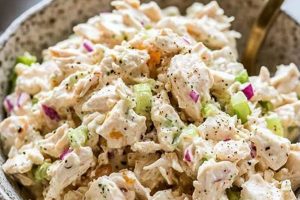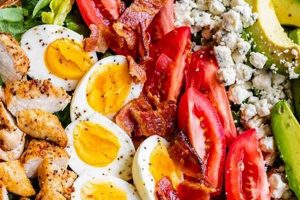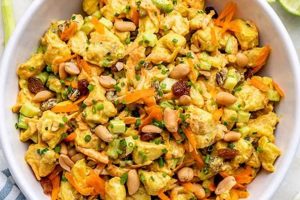Combining cooked chicken, cranberries, and mayonnaise forms the base of this popular dish. Variations frequently include celery, pecans, walnuts, red onion, and seasonings like salt, pepper, and curry powder. These salads can be served chilled on bread, croissants, crackers, lettuce cups, or as a standalone dish.
This dish offers a balance of sweet and savory flavors, with the tartness of cranberries complementing the richness of the chicken and mayonnaise. It provides a good source of protein and can incorporate other healthy ingredients, making it a nutritious meal or snack option. While the precise origin is unclear, the combination of chicken salad with fruits and nuts likely gained popularity in the mid-20th century with the rise of convenience foods and evolving palates.
Further exploration will cover various recipe variations, including those catering to specific dietary needs, tips for ingredient selection and preparation, and creative serving suggestions for different occasions.
Tips for Crafting Exceptional Chicken Salad with Cranberries
Optimizing ingredient selection and preparation techniques elevates this dish from simple to extraordinary. Attention to detail ensures a balanced flavor profile and desirable texture.
Tip 1: Chicken Selection: Using pre-cooked rotisserie chicken offers convenience. Alternatively, poaching or baking chicken breasts allows control over seasoning and ensures moist, tender results.
Tip 2: Cranberry Choices: Dried cranberries are standard, but fresh or frozen cranberries (chopped) offer a unique, brighter tartness. Consider cranberry sauce for added sweetness and moisture.
Tip 3: Mayonnaise Matters: High-quality mayonnaise is crucial. Experimenting with different types, such as olive oil-based or flavored mayonnaises, can enhance the overall flavor profile.
Tip 4: Nutty Additions: Toasted pecans or walnuts add a satisfying crunch and depth of flavor. Almonds, pistachios, or cashews offer interesting alternatives.
Tip 5: Celery Considerations: Finely diced celery contributes a refreshing crispness. For a milder flavor, remove the inner strings before chopping.
Tip 6: Seasoning Strategies: Salt and pepper are essential. Fresh herbs like dill, chives, or parsley add brightness. A touch of curry powder introduces a warm, savory note.
Tip 7: Chill Out: Chilling the salad for at least 30 minutes allows the flavors to meld and enhances the overall experience.
By implementing these tips, one can achieve a chicken salad with cranberries that is both flavorful and texturally satisfying, showcasing the harmonious blend of sweet, savory, and crunchy elements.
These guidelines provide a solid foundation for crafting a delicious and memorable dish. Experimentation with various ingredients and techniques allows for personalized variations.
1. Chicken (cooked, diced)
Cooked, diced chicken forms the foundational protein component of cranberry chicken salad recipes. The cooking method employed significantly influences the final dish’s flavor profile and texture. Roasting imparts a savory depth, while poaching yields a more neutral, succulent result. Dicing the chicken into bite-sized pieces ensures even distribution throughout the salad and facilitates consumption. Failure to properly cook the chicken poses health risks, while inconsistent dicing can lead to an uneven texture, affecting the overall culinary experience. For instance, using overcooked, dry chicken results in a less palatable salad, whereas undercooked chicken presents a serious health hazard.
The choice between white and dark meat also impacts the salad’s nutritional content and flavor. White meat, primarily breast meat, offers a leaner protein source with a milder taste. Dark meat, from thighs and legs, contains more fat and connective tissue, resulting in a richer flavor and moister texture. Recipes often specify white meat for a lighter salad, while dark meat contributes a more robust, savory dimension. Consider a recipe utilizing roasted dark meat for a smoky, intense flavor profile, contrasted with a recipe employing poached white meat for a lighter, cleaner taste.
Proper handling and preparation of the chicken are essential for food safety and optimal culinary results. Thorough cooking to an internal temperature of 165F (74C) eliminates harmful bacteria. Allowing the chicken to cool completely before dicing prevents the mayonnaise from separating and ensures a more appealing salad texture. Understanding the nuances of chicken selection and preparation techniques significantly contributes to a successful cranberry chicken salad recipe, highlighting the crucial role of this core ingredient.
2. Cranberries (dried, fresh)
Cranberries provide essential tartness and sweetness, balancing the richness of chicken and mayonnaise in cranberry chicken salad recipes. The choice between dried and fresh cranberries significantly impacts the salad’s texture, flavor profile, and overall culinary experience. Understanding these nuances allows for informed decisions regarding cranberry selection, enhancing recipe customization and optimization.
- Dried Cranberries
Dried cranberries offer a concentrated sweetness and chewy texture. Their widespread availability and extended shelf life make them a convenient choice. In cranberry chicken salad, they contribute a burst of sweetness with each bite and absorb excess moisture, stabilizing the salad’s consistency. However, their concentrated sweetness can sometimes overpower other flavors if used excessively.
- Fresh Cranberries
Fresh cranberries possess a brighter, more pronounced tartness compared to their dried counterparts. They offer a juicier, slightly firmer texture, adding a refreshing dimension to the salad. While their availability is seasonal, fresh cranberries impart a unique vibrancy to chicken salad. However, they may release more moisture, potentially affecting the salad’s consistency if not properly incorporated.
- Frozen Cranberries
Frozen cranberries offer a viable alternative to fresh cranberries, particularly outside of peak season. While they maintain a similar tartness profile, their texture becomes slightly softer upon thawing. This can be advantageous in chicken salad, contributing a burst of flavor without significantly altering the overall texture. Thawing and draining excess moisture before incorporating them into the salad is crucial.
- Cranberry Sauce
While not a pure cranberry form, cranberry sauce offers a unique way to incorporate cranberry flavor. Its smooth texture and added sweetness contribute a different dimension to the salad. However, the existing sweetness and potential added spices in the sauce require careful consideration to maintain flavor balance within the salad. Whole berry cranberry sauce can introduce textural variation.
The chosen cranberry form directly influences the final product’s flavor profile, texture, and moisture content. Dried cranberries offer convenience and sweetness, fresh cranberries provide vibrant tartness, and cranberry sauce adds a smooth, sweet element. By understanding these distinctions, one can tailor cranberry selection to specific preferences and desired culinary outcomes within cranberry chicken salad recipes.
3. Mayonnaise (binder, flavor)
Mayonnaise plays a crucial dual role in cranberry chicken salad recipes, functioning as both a binding agent and a significant flavor contributor. Its creamy texture holds the diverse ingredients together, creating a cohesive salad, while its inherent richness complements the other components, influencing the overall taste and mouthfeel. Careful selection and application of mayonnaise are essential for achieving the desired balance of flavors and textures within the salad.
- Binding Agent
Mayonnaise emulsifies the disparate ingredientschicken, cranberries, nuts, and vegetablesinto a unified mixture. This binding action prevents the salad from becoming dry and crumbly, ensuring a pleasant, creamy consistency. Without sufficient mayonnaise, the salad lacks cohesion, impacting both its visual appeal and palatability.
- Flavor Enhancement
Beyond its binding function, mayonnaise contributes a rich, tangy flavor that complements the sweetness of the cranberries and the savory notes of the chicken. The type of mayonnaise used significantly impacts the overall flavor profile. For instance, standard mayonnaise provides a classic taste, while olive oil-based mayonnaise offers a lighter, slightly peppery nuance. Flavored mayonnaises, such as those infused with herbs or spices, can further enhance the complexity of the salad’s flavor profile.
- Texture and Mouthfeel
Mayonnaise contributes significantly to the salad’s creamy texture and overall mouthfeel. The amount of mayonnaise used directly influences the final product’s richness and moisture content. Too little mayonnaise results in a dry, crumbly salad, while an excess can create an overly rich, heavy dish. Finding the right balance is crucial for achieving the desired textural qualities.
- Recipe Variations and Considerations
The choice of mayonnaise can be adapted to suit specific dietary needs or flavor preferences. Low-fat or fat-free mayonnaise options exist for those seeking to reduce caloric intake. Alternatively, homemade mayonnaise allows for complete control over ingredients and flavor profiles, offering opportunities for customization with different oils, vinegars, and seasonings. Adjusting the quantity of mayonnaise also allows for tailoring the salad’s consistency and richness.
Mayonnaise selection and utilization significantly impact the overall success of cranberry chicken salad recipes. Its binding properties, flavor contribution, and influence on texture and mouthfeel make it a critical ingredient. Careful consideration of these factors allows for creating a well-balanced and enjoyable culinary experience, showcasing the harmonious interplay of flavors and textures within this classic dish.
4. Nuts (texture, richness)
Nuts contribute a crucial textural and flavor dimension to cranberry chicken salad recipes. Their inclusion elevates the dish beyond a simple combination of ingredients, adding complexity and enhancing the overall sensory experience. Careful selection and application of nuts are essential for achieving the desired balance of textures and flavors within the salad.
- Textural Contrast
Nuts introduce a satisfying crunch and textural contrast to the otherwise soft consistency of the chicken salad. This contrast prevents the salad from becoming monotonous, providing a more engaging and enjoyable eating experience. The specific type of nut influences the intensity of the crunch; for example, walnuts offer a firmer crunch compared to the delicate crispness of pecans.
- Flavor Enhancement
Nuts impart distinct flavor profiles that complement the sweet and savory notes within the cranberry chicken salad. Walnuts offer a slightly earthy, robust flavor, while pecans provide a buttery sweetness. Almonds contribute a subtle sweetness and delicate crunch, whereas pistachios introduce a unique, slightly salty flavor profile. The choice of nut significantly influences the overall taste of the finished dish.
- Nutritional Value
Beyond their textural and flavor contributions, nuts offer nutritional benefits, adding healthy fats, protein, and fiber to the salad. These nutrients enhance the salad’s nutritional value, making it a more wholesome and satisfying meal option. The specific nutritional profile varies depending on the type of nut selected.
- Preparation and Incorporation
Proper preparation enhances the flavor and texture of nuts in cranberry chicken salad. Toasting nuts before adding them to the salad intensifies their flavor and enhances their crispness. Chopping the nuts into smaller pieces ensures even distribution throughout the salad and prevents large pieces from dominating the texture. Over-chopping, however, can lead to a loss of textural contrast.
The inclusion of nuts in cranberry chicken salad recipes elevates the dish from simple to sophisticated, adding textural complexity, enhancing flavor profiles, and boosting nutritional value. Careful consideration of nut selection, preparation, and incorporation methods ensures a harmonious balance of flavors and textures, resulting in a more satisfying and enjoyable culinary experience. Omitting nuts results in a less complex dish, lacking the desirable textural contrast and nuanced flavor dimensions they provide.
5. Seasoning (balance, depth)
Seasoning plays a critical role in cranberry chicken salad recipes, elevating the dish beyond a simple combination of ingredients. Strategic seasoning balances the inherent sweetness of cranberries, richness of mayonnaise, and savory notes of chicken, creating a harmonious flavor profile. Furthermore, it adds depth and complexity, transforming a basic salad into a culinary experience.
- Salt and Pepper: The Foundation
Salt and freshly ground black pepper form the foundational seasoning in virtually all cranberry chicken salad recipes. Salt enhances the inherent flavors of the other ingredients, while pepper adds a subtle bite and complexity. The quantity of each should be adjusted to taste, considering the saltiness of the chosen mayonnaise and other ingredients.
- Herbaceous Accents: Brightness and Freshness
Fresh herbs introduce brightness and complexity. Dill, chives, parsley, and tarragon offer distinct flavor profiles that complement the other ingredients. Finely chopped fresh herbs, added towards the end of the preparation process, maintain their vibrancy and aroma. Dried herbs can be substituted, but fresh herbs provide a superior flavor dimension.
- Spices: Warmth and Depth
A touch of spice can add warmth and depth to cranberry chicken salad. Curry powder introduces a warm, savory note that complements both the chicken and cranberries. A pinch of ground cumin or coriander can add earthy complexity. Experimentation with different spice combinations allows for personalized flavor profiles.
- Acidic Touches: Balancing Sweetness
A touch of acidity can balance the sweetness of the cranberries and richness of the mayonnaise. A squeeze of lemon juice or a splash of apple cider vinegar adds brightness and cuts through the richness, creating a more balanced flavor profile. The amount of acid should be carefully considered to avoid overpowering the other flavors.
Careful consideration of seasoning transforms cranberry chicken salad from a simple combination of ingredients into a well-balanced, flavorful dish. The interplay of salt, pepper, herbs, spices, and acidic elements creates depth and complexity, elevating the culinary experience. Proper seasoning ensures a harmonious blend of flavors, highlighting the distinct characteristics of each ingredient while creating a cohesive and satisfying final product. Neglecting proper seasoning results in a bland, one-dimensional salad, failing to capitalize on the potential for a truly flavorful and enjoyable culinary experience.
6. Serving (bread, lettuce)
Serving choices significantly influence the overall dining experience of cranberry chicken salad. The method of presentation impacts not only the ease of consumption but also complements the salad’s flavor profile and textural components. Bread and lettuce cups represent two common serving options, each offering distinct advantages and influencing the final culinary presentation.
Bread offers a classic and convenient vessel for cranberry chicken salad. Various bread types, from crusty sourdough to soft croissants, provide textural contrast and complement the salad’s creamy consistency. Sandwiches, wraps, or open-faced preparations offer versatility. The bread’s flavor profile should harmonize with the salad; for example, a multigrain bread complements the nutty and fruity notes. However, bread adds carbohydrates and calories, a consideration for dietary restrictions. Overly soft bread may become soggy, impacting the structural integrity of the serving.
Lettuce cups offer a lighter, lower-carbohydrate alternative. Crisp lettuce varieties, such as romaine or butter lettuce, provide a refreshing counterpoint to the rich salad. This serving method emphasizes the salad’s fresh components, creating a lighter, more health-conscious presentation. Lettuce cups cater to gluten-free diets and offer visual appeal. However, they may be less convenient for on-the-go consumption and lack the structural support of bread. Overfilling can lead to spillage, compromising the dining experience. Additionally, the lettuce’s water content might dilute the salad’s flavor over time.
Ultimately, the ideal serving method depends on individual preferences and dietary considerations. Bread provides a familiar, convenient, and structurally sound option, while lettuce cups offer a lighter, health-conscious alternative. Understanding the nuances of each serving method allows for a tailored culinary experience, maximizing enjoyment and complementing the unique flavors and textures of cranberry chicken salad. Beyond bread and lettuce, crackers, croissants, or even serving the salad as a standalone dish offer further possibilities, each influencing the overall presentation and dining experience.
Frequently Asked Questions
This section addresses common inquiries regarding cranberry chicken salad recipes, offering concise and informative responses to facilitate optimal preparation and enjoyment.
Question 1: What type of chicken is best suited for this salad?
While pre-cooked rotisserie chicken offers convenience, poaching or baking chicken breasts allows greater control over seasoning and yields a more tender result. Dark meat, such as chicken thighs, can also be utilized for a richer flavor profile.
Question 2: Can fresh cranberries be substituted for dried cranberries?
Fresh cranberries offer a brighter tartness compared to dried cranberries, but they may release more moisture, potentially affecting the salad’s consistency. Frozen cranberries, thawed and drained, offer a viable alternative.
Question 3: How can the salad’s richness be adjusted?
The amount of mayonnaise directly impacts the salad’s richness. Using less mayonnaise creates a lighter salad, while adding more results in a creamier, richer consistency. Greek yogurt can be incorporated to reduce overall fat content.
Question 4: What nuts complement cranberry chicken salad best?
Pecans and walnuts are classic choices, providing both flavor and textural contrast. Almonds, pistachios, or cashews offer viable alternatives, each contributing a unique flavor profile and level of crunch.
Question 5: How long can the salad be stored in the refrigerator?
Properly stored in an airtight container, cranberry chicken salad can typically be refrigerated for up to three to four days. Always check for signs of spoilage before consumption.
Question 6: Can this salad be frozen?
Freezing is not generally recommended, as the mayonnaise-based dressing can separate upon thawing, resulting in an undesirable texture. It is best enjoyed fresh or within a few days of preparation.
Addressing these common questions provides a comprehensive understanding of key aspects related to cranberry chicken salad recipes, enabling informed choices regarding ingredient selection, preparation methods, and storage practices.
The following section will offer variations on the classic recipe, showcasing diverse flavor profiles and catering to specific dietary needs and preferences.
Cranberry Chicken Salad Recipes
Examination of cranberry chicken salad recipes reveals a dish offering versatility and flavor complexity. From the foundational elements of cooked chicken and cranberries to the nuanced additions of mayonnaise, nuts, and seasonings, each component contributes distinct characteristics to the final product. Understanding the interplay of these ingredients allows for informed recipe customization, catering to individual preferences and dietary considerations. The choice between dried and fresh cranberries, the selection of nuts, and the strategic application of seasonings significantly impact the salad’s flavor profile, texture, and overall culinary appeal. Furthermore, serving methods, ranging from classic bread to lighter lettuce cups, further enhance the dining experience.
Cranberry chicken salad recipes represent more than a simple combination of ingredients; they offer a canvas for culinary creativity. Exploration of variations, informed by an understanding of core components and their interplay, allows for continuous refinement and personalization. This exploration encourages appreciation for the balance of flavors and textures achievable within this seemingly simple dish, solidifying its place as a versatile and enduring culinary staple.






